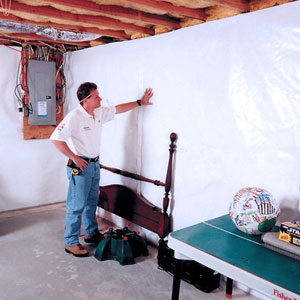
Resources
- Home
- Cheap Waterproof Walls
- How to Waterproof Basement Walls
- How to Waterproof Walls
- Waterproof Baesment Walls
- Waterproof Basement Walls
- Waterproof Bathroom Walls
- Waterproof Brick Walls
- Waterproof Concrete Walls
- Waterproof Exterior Walls
- Waterproof Foundation Walls
- Waterproof Garage Walls
- Waterproof Kitchen Walls
- Waterproof Wall Paint
- Waterproof Wall Panels
- Waterproof Walls Coating
- Waterproof Walls Companies
- Waterproof Walls Covering
- Waterproof Walls DIY
- Waterproof Walls FAQs
- Waterproof Walls Prices
Waterproof Basement Walls
The approach you take to waterproof your basement walls will depend on the specific situation you're currently dealing with in your basement. If you have an issue with seepage or leaks, you will want to repair them first. There are several reasons you may have this type of problem in your basement:
- The original installation was done in a shoddy manner
- Your home may have settled over time
- The water pressure outside your home has built up to a significant level
How to Prepare for Waterproofing
Unless a crack is extremely thin, it needs to be cleaned out and patched. For larger cracks, the best way to ensure they’re repaired properly is to use mortar. If you decide to take the DIY approach instead of hiring a contractor, you can mix your own mortar by combining 1 part cement, 2 parts fine sand and as little water as necessary to get the desired consistency. Smaller repairs can be handled with a latex cement or epoxy formula.
The exact method you use for applying mortar, latex cement or epoxy will depend on the type of leak you have in your basement. For example, a simple seeping leak just requires filling the trouble spot from the inside. However, a leak that's the result of excess pressure needs to be dealt with by chipping out space around the leak before filling it. The reason this additional step is necessary is because it will allow the mortar to set in a way that can withstand pressure.
How to Start Waterproofing
Once any existing problems in your basement are fixed, you can take care of actually waterproofing this space. Begin by moistening the walls you are going to waterproof. This step should be done with a very fine mist. The easiest way to get this amount of mist is to use a regular garden hose with an adjustable nozzle. In most cases, a wall needs to be fully smooth before it can be waterproofed. If you're planning to waterproof painted basement walls, you will want to remove the paint before you begin the actual waterproofing. This can be done with a wire brush, sand blaster or even sanding the wall by hand.
The Waterproofing Process
After a wall has been fully prepped, the waterproofing mixture can be applied to it. Slowly applying the mixture will ensure that all of the wall's pores are filled and the waterproofing job is fully effective. You'll get the best results if you use a stiff brush. It's also a good idea to begin applying the mixture at the bottom of the wall. Starting at the bottom will allow you to treat the wall where it faces the most water pressure.
As you or the contractor you hired apply the mix, move from the bottom of the wall to the top. Once you get to the top, apply additional layers of the mixture by working back down. After you're done, give the wall time to dry. Once it's dry, you can spray it off. After drying again, repeat this process one more time to fully waterproof your basement walls.
